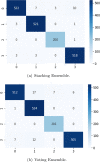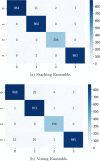Computer-aided diagnostic for classifying chest X-ray images using deep ensemble learning
- PMID: 36243705
- PMCID: PMC9568999
- DOI: 10.1186/s12880-022-00904-4
Computer-aided diagnostic for classifying chest X-ray images using deep ensemble learning
Abstract
Background: Nowadays doctors and radiologists are overwhelmed with a huge amount of work. This led to the effort to design different Computer-Aided Diagnosis systems (CAD system), with the aim of accomplishing a faster and more accurate diagnosis. The current development of deep learning is a big opportunity for the development of new CADs. In this paper, we propose a novel architecture for a convolutional neural network (CNN) ensemble for classifying chest X-ray (CRX) images into four classes: viral Pneumonia, Tuberculosis, COVID-19, and Healthy. Although Computed tomography (CT) is the best way to detect and diagnoses pulmonary issues, CT is more expensive than CRX. Furthermore, CRX is commonly the first step in the diagnosis, so it's very important to be accurate in the early stages of diagnosis and treatment.
Results: We applied the transfer learning technique and data augmentation to all CNNs for obtaining better performance. We have designed and evaluated two different CNN-ensembles: Stacking and Voting. This system is ready to be applied in a CAD system to automated diagnosis such a second or previous opinion before the doctors or radiology's. Our results show a great improvement, 99% accuracy of the Stacking Ensemble and 98% of accuracy for the the Voting Ensemble.
Conclusions: To minimize missclassifications, we included six different base CNN models in our architecture (VGG16, VGG19, InceptionV3, ResNet101V2, DenseNet121 and CheXnet) and it could be extended to any number as well as we expect extend the number of diseases to detected. The proposed method has been validated using a large dataset created by mixing several public datasets with different image sizes and quality. As we demonstrate in the evaluation carried out, we reach better results and generalization compared with previous works. In addition, we make a first approach to explainable deep learning with the objective of providing professionals more information that may be valuable when evaluating CRXs.
Keywords: CNN; COVID-19 classification; Deep ensemble learning; Grad-CAM; Stacking; Voting.
© 2022. The Author(s).
Conflict of interest statement
The authors declare no competing interests.
Figures












Similar articles
-
COV-MobNets: a mobile networks ensemble model for diagnosis of COVID-19 based on chest X-ray images.BMC Med Imaging. 2023 Jun 15;23(1):83. doi: 10.1186/s12880-023-01039-w. BMC Med Imaging. 2023. PMID: 37322450 Free PMC article.
-
Automated detection of COVID-19 using ensemble of transfer learning with deep convolutional neural network based on CT scans.Int J Comput Assist Radiol Surg. 2021 Jan;16(1):115-123. doi: 10.1007/s11548-020-02286-w. Epub 2020 Nov 16. Int J Comput Assist Radiol Surg. 2021. PMID: 33191476 Free PMC article.
-
CNN-RNN Network Integration for the Diagnosis of COVID-19 Using Chest X-ray and CT Images.Sensors (Basel). 2023 Jan 25;23(3):1356. doi: 10.3390/s23031356. Sensors (Basel). 2023. PMID: 36772394 Free PMC article.
-
Classification of COVID-19 chest X-Ray and CT images using a type of dynamic CNN modification method.Comput Biol Med. 2021 Jul;134:104425. doi: 10.1016/j.compbiomed.2021.104425. Epub 2021 Apr 29. Comput Biol Med. 2021. PMID: 33971427 Free PMC article.
-
A Survey on AI Techniques for Thoracic Diseases Diagnosis Using Medical Images.Diagnostics (Basel). 2022 Dec 3;12(12):3034. doi: 10.3390/diagnostics12123034. Diagnostics (Basel). 2022. PMID: 36553041 Free PMC article. Review.
Cited by
-
COV-MobNets: a mobile networks ensemble model for diagnosis of COVID-19 based on chest X-ray images.BMC Med Imaging. 2023 Jun 15;23(1):83. doi: 10.1186/s12880-023-01039-w. BMC Med Imaging. 2023. PMID: 37322450 Free PMC article.
-
The two-stage detection-after-segmentation model improves the accuracy of identifying subdiaphragmatic lesions.Sci Rep. 2024 Oct 25;14(1):25414. doi: 10.1038/s41598-024-76450-6. Sci Rep. 2024. PMID: 39455821 Free PMC article.
-
Diagnostic Performance of Artificial Intelligence-Based Methods for Tuberculosis Detection: Systematic Review.J Med Internet Res. 2025 Mar 7;27:e69068. doi: 10.2196/69068. J Med Internet Res. 2025. PMID: 40053773 Free PMC article.
-
Clinical Applications of Machine Learning.Ann Surg Open. 2024 Apr 18;5(2):e423. doi: 10.1097/AS9.0000000000000423. eCollection 2024 Jun. Ann Surg Open. 2024. PMID: 38911656 Free PMC article. Review.
-
Artificial Intelligence: Knowledge and Attitude Among Lebanese Medical Students.Cureus. 2024 Jan 1;16(1):e51466. doi: 10.7759/cureus.51466. eCollection 2024 Jan. Cureus. 2024. PMID: 38298326 Free PMC article.
References
-
- World Health Organization. Weekly epidemiological update on COVID-19—29 June 2021. Edition 46 (2021). https://www.who.int/publications/m/item/weekly-epidemiological-update-on....
-
- World Health Organization. Weekly epidemiological update on COVID-19—4 May 2022. (2022). https://www.who.int/publications/m/item/weekly-epidemiological-update-on....
-
- Niyaz U, Sambyal AS, et al. Advances in deep learning techniques for medical image analysis. In: 2018 fifth international conference on parallel, distributed and grid computing (PDGC). IEEE; 2018. p. 271–77.
Publication types
MeSH terms
LinkOut - more resources
Full Text Sources
Medical
Research Materials
Miscellaneous

